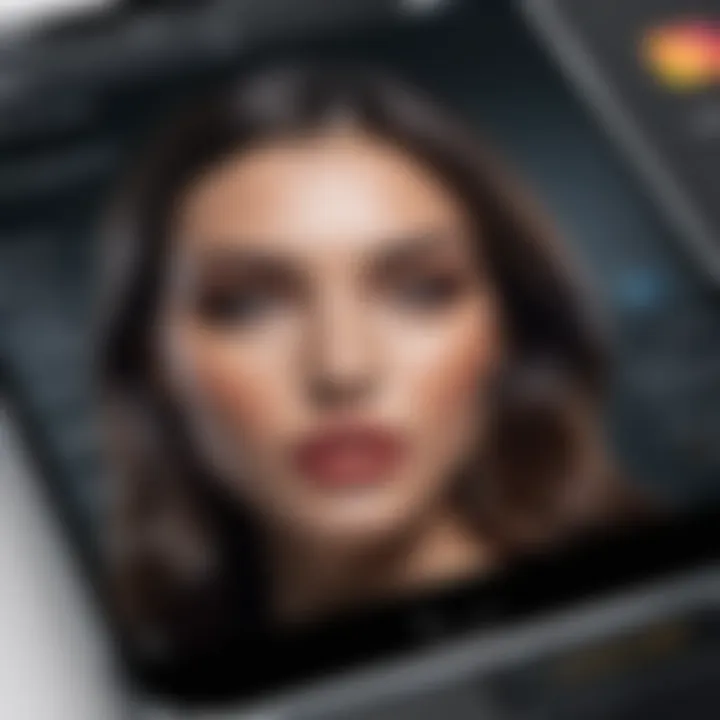Mastering Photo Layout on iPhone: A Comprehensive Guide


Intro
Creating stunning photo layouts on an iPhone involves understanding the available tools and techniques. The iPhone, particularly in its latest models, offers users a variety of built-in features and applications that can elevate ordinary photography into a refined art form. In this guide, we will explore these tools, examining how to make engaging photo collages, effectively arrange images, and employ best practices for layout design. This journey aims to equip users of all skill levels—from beginners to seasoned photography enthusiasts—with the skills needed to create visually appealing and professional-looking photo arrangements.
Understanding Photo Layout
Creating visually appealing photo layouts is essential in today's digital world. Mastering the art of photo layout on the iPhone goes beyond mere aesthetics; it helps convey messages and emotions. Within this section, we will explore the fundamental importance of understanding photo layout, which is vital for anyone wishing to effectively present their photography.
Definition of Photo Layout
Photo layout refers to the arrangement of images and their composition within a designated space. It involves selecting, positioning, and organizing photos in a way that enhances visual appeal. The choice of layout can drastically affect how viewers perceive and engage with the images presented. On the iPhone, users have varied tools and features at their disposal, simplifying the layout process. This includes simple grids, collages, or more complex designs, allowing creativity to flourish. This capability enriches the overall experience for both the creator and the observer.
Importance in Digital Sharing
In the age of social media, photo layout plays a crucial role in digital sharing. With endless competition for attention, having a well-organized and striking photo layout can determine the impact of your photographs. A thoughtfully crafted layout will not only attract viewers but also encourage interaction and shares. Proper layouts can effectively convey narratives or moods associated with particular images.
Using a consistent approach to photo layouts helps maintain a personal brand, especially for those who share content frequently on platforms like Instagram or Facebook.
"In a world overflowing with visuals, the first impression often comes from the arrangement of images, making it essential to get it right."
Additionally, understanding the nuances of layouts can help users save time and enhance the storytelling aspect of their photography. By carefully considering elements such as balance, alignment, and contrast, individuals can achieve professional-grade visuals right from their iPhones.
Essential Tools on iPhone
The foundation for creating appealing photo layouts on an iPhone begins with the right tools. Understanding the available tools is crucial for users wanting to maximize their photography experience. The native apps on the iPhone offer a solid starting point. Additionally, exploring third-party applications expands the possibilities, providing unique features and enhancements. This section will breakdown these tools to help users make informed decisions about their photo layout endeavors.
Native Photos App Overview
The Native Photos App on the iPhone is an essential tool. It provides users with a comprehensive platform for organizing, editing, and sharing photographs. With iOS constantly evolving, the Photos App now includes a variety of powerful features.
Users can easily create albums, edit images, and apply simple layouts without the need for additional software. The intuitive interface is designed for efficiency, making it accessible to novices while still offering depth for more experienced users. Overall, the Photos App serves as a reliable cornerstone for completing basic photo layout tasks.
Third-Party Applications
For users looking for more advanced features, third-party applications can be invaluable. These apps often provide unique functionalities that enhance creativity and customization. They cater to different aspects of photo editing and layout creation.
Overview of Popular Apps
Popular third-party apps like Canva, Pic Collage, and Layout from Instagram have emerged as strong contenders in the realm of photo layout design. Each of these applications brings something unique to the table. For example, Canva offers an extensive library of templates that can help users create polished designs quickly.
The flexibility of these applications allows for a higher degree of customization, which may not be possible with the Native Photos App alone. Users can explore various options for layering images, adding text, and utilizing ready-made graphics. This ability to manipulate elements easily contributes to the appeal of these apps.
Criteria for Selection
When selecting a third-party app, certain criteria must be considered. User-friendliness stands out as a key characteristic. A straightforward interface ensures that users can navigate options without frustration. Looking into features like template variety, compatibility with social media platforms, and export options is important. These elements can significantly impact the overall user experience.
Users should evaluate the unique features of each app. Some may lean towards rich editing tools, while others might prioritize layout options. Identifying one’s specific needs will guide the selection process, ensuring an optimal fit for photo layout tasks.
Creating Photo Layouts Using the Photos App
Creating photo layouts on your iPhone through the Photos app is essential for users looking to organize and showcase their images. The built-in capabilities of this app allow users to manipulate their photos without needing additional software. Therefore, understanding how to effectively use these features can lead to more creative and visually appealing results.
Accessing the Photos App
To start, opening the Photos app is the first crucial step. This application is pre-installed on every iPhone. You can find it on the home screen. Once you open it, you will notice your photos are automatically organized in various albums. This feature helps streamline the process of selecting images for your layouts. The app’s user-friendly interface makes it easy to navigate through your gallery.
Selecting Photos for Layout
Selecting the right photos is fundamental to creating striking layouts. Careful consideration of the images you choose will impact how effectively you can convey your message or theme.


Best Practices for Selection
When approaching the best practices for selection, consider the visual consistency among your photos. Aim for images with similar colors or themes. This contributes to a more harmonious layout, making it easier for the viewer to focus on the central subject of your arrangement.
Key characteristics of effective photo selection include:
- Diversity: Mix close-ups with wider shots to create depth.
- Complementarity: Choose images that tell a story together.
A unique feature of this practice is the ability to create a cohesive narrative. While variety can be stimulating, it is essential to maintain a sense of unity. This ensures that the layout does not appear chaotic or disengaged.
Creating Collections
When you create collections within the Photos app, you essentially group selected images into a cohesive set. This action is beneficial for organizing photos that belong to a specific event or theme, simplifying access when designing your layout.
A key aspect of creating collections is its user-friendly interface, allowing for easy addition and removal of photos.
Some benefits of this approach include:
- Easier navigation when sourcing images for future projects.
- Simplified sharing of themed collections with others.
However, one drawback might be that collections can become cluttered if not managed consistently. Regularly updating and refining your collections can mitigate this issue.
Using the Collage Feature
The collage feature is an exciting tool within the Photos app. This allows users to combine multiple images into a single frame, creating a visually appealing layout. The process typically involves selecting the images you want to include, clicking on the collage option, and then customizing the layout to your liking. This offers a quick way to create something meaningful without requiring extensive graphic design knowledge.
Photo Editing Basics
Photo editing is an essential part of mastering photo layouts on the iPhone. Understanding how to edit enhances the overall quality of images, allowing them to look their best for various sharing purposes. Photo editing serves not just the aesthetics but also the message behind each image. Therefore, a solid grasp of input and output requirements can significantly impact how final layouts are perceived. This section will cover key features of photo editing available on the iPhone, providing insights into their practical applications.
Cropping and Resizing
Cropping is one of the most basic yet effective tools in photo editing. It allows users to eliminate unwanted sections of an image, focusing attention on the significant elements. For iPhone users, using the Photos app to crop photos is quite straightforward. It also resizes images to fit specific frame requirements, a crucial factor in layout design.
- Aspect ratio: Different platforms require varying dimensions. Knowing which ratio fits best is necessary. Common ratios include 1:1 for Instagram and 16:9 for Facebook or YouTube.
- Guidelines: Use the grid feature to align your photos better. This helps to create harmonious compositions.
Overall, cropping and resizing not only adjust the look of individual images but also affect the overall harmony of the layout.
Applying Filters
Filters can be a powerful tool in your editing arsenal. They transform the look and feel of your images, lending a cohesive mood to collections. For instance, applying a vintage filter can unify a series of photos taken in different settings.
- Subtle enhancements: Sometimes, a small adjustment is all that is needed. Filters can improve color balance without altering the original content.
- Creative expression: Different filters evoke distinct emotions. Choosing filters that enhance the narrative of the layout is essential for meaningful presentations.
When using filters, it is essential to remember that less can be more. Overly bold adjustments can detract from the images rather than enhance them.
Adjusting Brightness and Contrast
Brightness and contrast are fundamental parameters when editing images. The iPhone Photos app provides tools to manage these settings effectively.
- Brightness: Adjusting brightness can help clarify subjects in poorly lit images. Careful manipulation can bring out details that enhance the overall layout.
- Contrast: Increasing contrast can make colors pop, drawing attention to specific elements. However, excessive contrast can lead to loss of detail.
"Photo editing is not about altering reality but enhancing it. Each feature complements the artist's vision."
By mastering cropping, applying filters wisely, and adjusting brightness and contrast appropriately, users can significantly improve their layout presentations. This knowledge is essential for anyone looking to create impactful, engaging photo displays.
Advanced Layout Techniques with Third-Party Apps
Utilizing third-party applications for creating photo layouts on your iPhone can significantly enhance your creative scope. Unlike the native Photos app, these applications provide advanced features that facilitate intricate designs and tailored options. For tech-savvy individuals or those who deeply appreciate photography, mastering these tools can elevate their output substantially.
Using Canva for Layout Design


Canva has gained a reputation as one of the leading graphic design platforms globally. It offers an intuitive interface, making it easy to navigate for users of all experience levels. Users can choose from a vast library of templates designed specifically for various social media platforms.
To use Canva for layout design:
- Start by downloading the Canva app from the App Store.
- Create an account or log in for easy access to your designs.
- Choose a template or start from scratch with custom dimensions.
- Import your selected photos directly from your iPhone’s gallery.
- Utilize the drag-and-drop feature to position photos precisely where you want them.
- Add text or other design elements to enhance your composition.
One of the key advantages of Canva is its collaboration options, allowing multiple users to work on a design in real time. This feature is particularly beneficial for those working on shared projects.
Utilizing Layout from Instagram
The Layout app from Instagram offers a different approach. It is designed explicitly for creating collages with ease. This app is a straightforward tool for those who seek simplicity in their photo arrangements.
To start using Layout:
- Download the Layout app, which is free and user-friendly.
- Select photos from your camera roll to create a collage.
- Choose the layout that best fits the number of images selected.
- Adjust sizes by zooming in or out and rearranging by dragging images.
The automatic face detection feature makes it easy to highlight important elements in your photos. Though not as feature-comprehensive as Canva, Layout is excellent for quick and simple designs without losing quality.
Exploring Pic Collage Features
Pic Collage is another robust application that excels in providing tools for creative expression. This tool includes various stickers, templates, and backgrounds, allowing users to personalize their collages further.
To navigate Pic Collage:
- Download and open the Pic Collage app.
- Choose your preferred style: freestyle, grid, or template collage.
- Import images from your gallery or social media accounts.
- Take advantage of the sticker library, adding design elements seamlessly.
- Use the text tool to include quotes or captions that resonate with the visuals.
The blend of creativity and ease of use makes Pic Collage a favorite among those who want to create visually appealing artworks without extensive design knowledge.
Optimizing Layouts for Social Media
Optimizing photo layouts for social media plays a critical role in ensuring your content resonates with the target audience. In an age where visual storytelling dominates online platforms, how a photograph is arranged greatly influences engagement. Different social media platforms have unique characteristics and user expectations, requiring tailored approaches for optimal layouts. This section delves into the intricacies of creating layouts that not only capture attention but also maintain compatibility with various platforms.
Understanding Platform Requirements
Each social media platform has specific requirements regarding image sizes, resolutions, and formats. Knowing these specifications helps you design layouts that look professional and meet platform standards.
- Facebook: Recommended image sizes vary depending on the type of post—feed images should ideally be 1200 x 630 pixels, while cover photos require 820 x 312 pixels.
- Instagram: Square posts perform well at 1080 x 1080 pixels. Portrait images are best displayed at 1080 x 1350 pixels, giving added height that captures viewers’ attention.
- Twitter: A standard image should be sized at 1200 x 675 pixels to ensure proper display without truncation.
Understanding these guidelines can significantly enhance your ability to craft layouts that look appealing and polished on social media feeds.
Aspect Ratios and Dimensions
Aspect ratios dictate how images are displayed across platforms. They impact not only the aesthetic appeal but also functionality.
- Common Aspect Ratios: Most platforms favor 1:1 (square) for Instagram and Facebook, while a 16:9 ratio is ideal for Twitter.
- Dimensions Matter: Choosing the right dimensions ensures that the image does not get cut off or distorted when displayed. Ensuring that images are optimized for different screens, especially mobile, is also essential as a large portion of social media users access platforms from their smartphones.
In summary, when creating photo layouts, always consider the platform where the image will be posted. By aligning your designs with specific requirements and aspect ratios, you can maximize the impact of your visuals, enhancing both engagement and shareability.
Printing and Sharing Your Layouts
Printing and sharing your photo layouts is a key aspect of finalizing your creative efforts on the iPhone. This section will discuss why these actions matter in showcasing your work and communicating your vision.
The ability to print layouts allows you to produce tangible copies of your designs, which can be used in various formats. Sharing, on the other hand, enables you to reach a broader audience, promoting your work on platforms where it can be appreciated. Depending on your target audience, choosing how you present your layouts can have significant implications.
Exporting Your Designs
Exporting your designs from the iPhone is straightforward. When you are satisfied with your layout, you can save or export it to the desired format. Common formats include JPEG and PNG for images.
- Go to the app you used for creating your layout.
- Select the export option, often found in the share menu.
- Choose the format and resolution.
- Save the exported file to your device or cloud storage.
This step is crucial as it sets the quality of your final output, impacting how the design looks when printed or shared online.
Choosing Print Options


Choosing between online services and local print shops can determine the quality and convenience of your printed layouts. An informed decision is key for achieving the best results.
Online Services
Using online services for printing offers convenience, especially if you are looking for quick and easy solutions. Online platforms such as Shutterfly or Vistaprint allow users to upload designs and select various print options.
- Key characteristic: Accessibility. Users can print from anywhere with internet.
- Unique feature: Many services offer templates and design suggestions, which can enhance the final product.
- Advantages: Often quick and can deliver straight to your address.
- Disadvantages: Quality may vary between services and shipping times can be long.
Local Print Shops
Local print shops can be a great option for those who prefer hands-on interactions. By visiting a shop, you can see sample prints and discuss specific requirements with professionals.
- Key characteristic: Personalization. You can communicate directly with the staff and receive immediate feedback.
- Unique feature: They often have options for different types of paper and finishes, allowing for greater customization.
- Advantages: Immediate service and often higher quality control.
- Disadvantages: May be limited to local offerings and potentially higher costs compared to online services.
Sharing on Social Media Platforms
Sharing your photo layouts on social media platforms is essential in today’s digital world. It allows you to showcase your creativity and connect with a community of like-minded individuals. Platforms like Instagram and Facebook provide opportunities for networking and exposure.
- Select the right platform for your layout.
- Before sharing, consider formatting your layout to fit the platform’s requirements.
- Use relevant hashtags to increase visibility.
- Engage with your audience through comments and direct messages.
In summary, effectively printing and sharing your layouts can amplify the reach of your work and enhance your visibility within the creative community. Focus on the quality of prints and the way you present your work online. This will significantly affect how your creativity is perceived.
Troubleshooting Common Issues
Troubleshooting common issues is essential for anyone creating photo layouts on the iPhone. Mastering the nuances of layout design requires not only creativity but also the ability to address various technical challenges. These challenges can hinder a user's ability to produce compelling content, thus making troubleshooting a vital skill. This section covers two common issues: app crashes and performance slows, as well as design misalignments. Understanding these problems will enhance your efficiency and enable you to utilize your tools more effectively.
App Crashes and Performance Slows
App crashes can disrupt your workflow, particularly when engaged in the creative process. Such interruptions can be frustrating and may lead to lost progress. Common reasons for crashing include insufficient storage and memory allocation. When many apps run concurrently, it can significantly slow down your device, resulting in crashes or unresponsive applications.
To mitigate these issues, consider the following steps:
- Close Unused Apps: Regularly check and terminate any background apps you don’t need. This frees up resources.
- Restart Your Device: Sometimes, a simple restart can clear temporary data and refresh the system.
- Free Up Space: Aim to keep at least 10-15% of your device’s storage free. Delete unnecessary files and photos.
- Update Apps and iOS: Ensure all apps and your operating system are up to date. Updates often fix bugs that lead to crashes.
"Regular maintenance not only improves the performance of your iPhone but also minimizes disturbances during critical creative tasks."
By following these steps, you can enhance the stability of your photo editing applications and create without interruption.
Design Misalignments
Design misalignments occur when elements within the layout don't align as intended. This can happen for various reasons, including differing image sizes, incorrect cropping, or software glitches. Misalignments not only affect the aesthetic appeal of your layout but may also frustrate users who expect precision in their designs.
To resolve design misalignments, keep the following strategies in mind:
- Check Image Sizes: Make sure all images are sized appropriately for the layout you desire. Use a consistent aspect ratio to maintain uniformity.
- Adjust Layer Orders: Sometimes elements may overlap incorrectly. Review the layer order and adjust as necessary.
- Zoom In for Detail: Utilizing zoom can help catch small misalignments that are not noticeable at a normal view.
- Preview Before Finalizing: Always preview your layout before sharing or printing. This allows you to catch any final errors.
Attention to detail during the design process can help prevent misalignments, ensuring your layouts appear polished and professional. Incorporating these solutions will enhance both your workflow and the overall quality of your photo layouts.
Ending and Future Considerations
In the modern digital age, mastering the art of photo layout on the iPhone is not merely a skill but a significant avenue for self-expression and communication. Understanding the tools, apps, and techniques discussed throughout this guide enables users to create visually compelling images that resonate with viewers. This final section underscores the importance of reflection on the key takeaways and highlights what lies ahead in the world of photo layouts.
Recap of Key Points
To effectively summarize our discussion, here is a recap of the essential points:
- The significance of photo layout in enhancing digital imagery.
- Key tools available directly on the iPhone and through third-party applications.
- Basic photo editing skills such as cropping, resizing, and applying filters that improve layout aesthetics.
- The utilization of advanced techniques offered by apps like Canva and Pic Collage for design precision.
- The importance of optimizing layouts for various social media platforms to maximize visibility and engagement.
- Troubleshooting tips for common issues, ensuring a smooth design process, and achieving desired results.
- Future trends in photo layout that hint at an evolving landscape in digital photography.
Understanding these points provides a solid foundation for anyone seeking to advance their skills in photo layouts on the iPhone. This knowledge not only fosters creativity but also builds confidence in digital storytelling.
Emerging Trends in Photo Layout
As we move forward in the realm of photography, several trends are emerging:
- Augmented Reality (AR) Integration: More apps are beginning to incorporate AR features, allowing users to see how layouts would look in real time. This innovation helps users visualize their designs better.
- Artificial Intelligence (AI) Enhancements: AI is being harnessed to automate design suggestions, making it easier for users to create impressive layouts without extensive technical know-how.
- Minimalist Design Preferences: There is a growing trend towards simplified and minimalist layouts. Users are increasingly favoring clean designs that highlight the photo content without overwhelming details.
- Sustainable Photography Practices: Ethical and sustainable photography is gaining traction, with users looking for ways to produce layouts that are mindful of environmental impacts.
- Interactive Layouts: Finally, interactive photo layouts that allow viewers to engage with content dynamically are on the rise, expanding the boundaries of visual storytelling.
Staying abreast of these trends will equip users with the foresight needed to adapt their techniques and strategies accordingly. Embracing innovation will ensure that your photo layouts remain fresh and impactful.







